
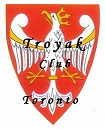

15. ROCZNICA ŚMIERCI OJCA ŚWIĘTEGO JANA PAWŁA II
15th ANNIVERSARY OF POPE ST. JOHN PAUL II DEATH
18.05.1920 – 2.04.2005

HAPPY EASTER !
WESOŁYCH ŚWIĄT WIELKANOCNYCH !
JOYEUX PÂQUES !


KWIECIEŃ – MIESIĄC PAMIĘCI OFIAR ZBRODNI KATYŃSKIEJ … 1940
APRIL – MONTH MEMORY OF VICTIMS OF THE KATYN MASSACRE … 1940

TROYAK EXECUTIVE TEAM is informing all members, colleagues, collectors, and Polonia at large, that Club meetings taking place at John Paul II Polish Cultural Centre, 4300 Cawthra Rd. (just south of Hwy. 403), Mississauga, Ontario. The new members are always welcome. www.polishculturalcentre.ca
ADRES SPOTKAÑ KLUBOWYCH ! Zarząd Główny Klubu “Troyak” informuje wszystkich członków kolekcjonerów, sympatyków oraz całą Polonię, że spotkania klubowe odbywają się w Polskim Centrum Kultury im. Jana Pawła II, przy 4300 Cawthra Rd. (na południe od autostrady 403), Mississauga, Ontario. Zapraszamy nowych członków do prężnego. Klubu “Troyak”. www.polishculturalcentre.ca

“TROYAK” CLUB NEXT MEETINGS …
NASTĘPNE SPOTKANIA KLUBU “TROYAK” …
26th April 2020 @ 4:30 p.m. CANCELLED !
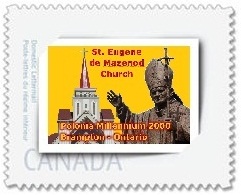

31st May 2020
28th June 2020

July & August 2020 – Summer break … Letnie wakacje …

TROYAK CLUB @ Roncesvalles Polish Festival 2020
Saturday, September 12th … Sunday, September 13th, 2020
https://polishfestival.ca www.kazimierz.org

27th September 2020

4th October 2020 @ 9:00 a.m. to 4:00 p.m. …
Mississauga’s 5th Annual Fall Show
25th October 2020; 29th November 2020

100. Rocznica nawiązania relacji dyplomatycznych Polski i USA
100th Anniversary of Establishing Diplomatic Relations
between Poland and the USA
www.poczta-polska.pl
W dniu 20 grudnia został wprowadzony do obiegu znaczek pocztowy o wartości 3,30zł emisji „100. Rocznica nawiązania relacji dyplomatycznych Polski i USA”. Na znaczku widnieje fragment pocztówki autorstwa Artura Szyka pt. ,,Wilson i Paderewski”, przedstawiający postaci Ignacego Jana Paderewskiego i Woodrowa Wilsona. Znaczki wydrukowano techniką offsetową, na papierze fluorescencyjnym, w formacie 31,25 x 43 mm, po 144 000 sztuk. Arkusz sprzedażny zawiera 12 sztuk znaczków. Z tej okazji została wydana koperta FDC. Autor projektu: Roch Stefaniak.
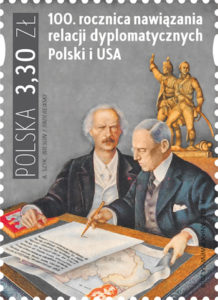
100th Anniversary of Establishing Diplomatic Relations
between Poland and the USA … denomination: 3,30 PLN;
number of stamps in set: 1; print run: 144.000 pcs;
printing technique: offset; stamp size: 31,25 x 43 mm;
number of FDC: 1; author: Roch Stefaniak;
circulation date: 20th December 2019.
Autor znaczka, Roch Stefaniak przedstawił na nim reprodukcję litografii Artura Szyka „Wilson i Paderewski” pochodzącej z pocztówki wydanej w 1939 r. Dodatkowo Poczta Polska wyemitowała kopertę FDC – wydawaną w pierwszym dniu obiegu znaczków. Widnieje na niej logo obchodów 100. rocznicy nawiązania relacji dyplomatycznych Polski i USA.
– Pragniemy upamiętnić 100 rocznicę nawiązania stosunków dyplomatycznych pomiędzy Polską i Stanami Zjednoczonymi. Znaczek w sposób symboliczny przedstawia akt dopisania postulatu o utworzeniu niepodległego państwa polskiego do orędzia prezydenta Stanów Zjednoczonych Thomasa Woodrowa Wilsona. Należy pamiętać, że związki Polski ze Stanami Zjednoczonymi oparte są na wspólnych fundamentalnych wartościach, poszanowaniu uniwersalnych praw, na demokracji i godności istoty ludzkiej – powiedział prezes Poczty Polskiej Przemysław Sypniewski.
W orędziu wygłoszonym na początku 1918 roku przed amerykańskim Kongresem ówczesny prezydent USA Thomasa Woodrow Wilson powiedział, że „należy stworzyć niezawisłe państwo polskie, które winno obejmować terytoria zamieszkane przez ludność niezaprzeczalnie polską, któremu należy zapewnić swobodny i bezpieczny dostęp do morza i którego niezawisłość polityczną i gospodarczą oraz integralność terytorialną należy zagwarantować paktem międzynarodowym”. Polska pojawiła się na mapie Europy w listopadzie 1918 roku, a już dwa miesiące później zostały nawiązane stosunki dyplomatyczne z USA. Pierwszym przedstawicielem Stanów Zjednoczonych w odrodzonej Polsce był Hugh S. Gibson. 2 maja 1919 roku złożył on w Belwederze list akredytacyjny, a już następnego dnia uczestniczył w uroczystościach upamiętniających uchwalenie Konstytucji 3 maja. Uznanie podmiotowości Rzeczypospolitej przez Amerykanów było wyraźnym sygnałem dla pozostałych mocarstw do podjęcia analogicznych kroków. W roku 2019 Poczta Polska upamiętniła także okolicznościowymi znaczkami 100 rocznicę nawiązania stosunków dyplomatycznych z Francją, Grecją oraz Watykanem.

Miasta polskie – Leszno
Polish cities – Leszno
www.poczta-polska.pl
Leszno jest kolejnym tematem znaczka filatelistycznej serii „Miasta polskie”. Walor o wartości 3,30 zł trafił do obiegu 17 stycznia z okazji 100. rocznicy powrotu miasta do granic Rzeczypospolitej. Poczta Polska w ramach emisji filatelistycznych honoruje najważniejszych polskich bohaterów i największe wydarzenia naszej historii, ale również upamiętnia polskie miasta i miejsca.
Polska odzyskała niepodległość 11 listopada 1918 roku, jednak Leszno powróciło do Polski dopiero na mocy traktatu wersalskiego 17 stycznia 1920 roku. Na wydawanym właśnie znaczku obiegowym Poczty Polskiej w cyklu prezentującym polskie miasta, przedstawiono fragment pomnika Wdzięczności Powstańcom Wielkopolskim na tle ratusza w Lesznie. Znaczek wyemitowano w nakładzie 30 mln sztuk. Siedziba leszczyńskich władz miejskich to barkowy budynek z XVII wieku (później strawiony przez pożar i odbudowany na początku XVIII wieku). Architektem trzykondygnacyjnej budowli na planie prostokąta był Włoch Pompeo Ferrari. Natomiast powstańczy monument ufundowany został w 1924 roku. W 1957 roku zrekonstruowano go i ponownie odsłonięto. Wykonany jest z piaskowca. Z przodu pomnika znajduje się orzeł oraz data 28 XII 1918. Z lewej strony widnieje napis: „Powstańcom Wielkopolskim 1918–1919”, a z prawej: „Wdzięczni Rodacy 1924”. Oprócz znaczka Poczta Polska wydała kopertę FDC (pierwszego dnia obiegu), na której została przedstawiona panorama Leszna.

Wartość: 3,30 zł … autor projektu znaczka: Andrzej Gosik;
liczba znaczków: 1; nakład: 30 000 000 szt.; papier: fluorescencyjny;
technika druku: rotograwiura; format znaczka: 31,25 x 25,5 mm;
arkusz sprzedażny: 100 znaczków;
data wprowadzenia do obiegu: 17 stycznia 2020 r.
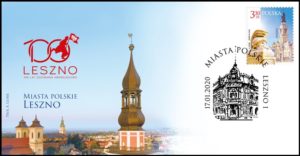
Polish cities – Leszno … denomination: 3,30 PLN;
number of stamps in set: 1; 100 pcs in sheet;
print run: 30.000.000 pcs; printing technique: rotogravure;
stamp size: 31,25 x 25,5 mm; author: Andrzej Gosik;
release date: 17th January 2020.
Do tej pory w ramach serii obiegowej „Miasta polskie” Poczta Polska zaprezentowała Gniezno, Kraków, Warszawę, Kalisz, Płock, Toruń, Pułtusk (na kopercie z nadrukowanym znakiem opłaty pocztowej), Kazimierz Dolny, Sandomierz, Gdańsk, Łódź (z przywieszką Priorytet), Poznań, Przemyśl, Szczecin, Sopot, Sieradz, Katowice, Częstochowę, Gorzów Wlkp., Chorzów, Racibórz, Jelenią Górę, Nowy Sącz, Żywiec i Białystok. Cykl zapoczątkował artysta grafik Andrzej Gosik, korzystając z techniki akwarelowej. Maria Dziekańska zaprojektowała znaczki prezentujące Szczecin, Sopot, Sieradz, Katowice i Częstochowę, Jerzy Pietras – Gorzów Wlkp., a Monika Żyła-Kwiatkowska – Chorzów.

100-lecie powrotu Torunia do wolnej Polski
100 years of Torun’s return to free Poland
www.poczta-polska.pl
Dnia 18 stycznia 2020 r. została wprowadzona do obiegu kartka pocztowa z nadrukowanym znakiem opłaty pocztowej, emisji: 100-lecie powrotu Torunia do wolnej Polski. Wartość nominalna znaku opłaty pocztowej z oznaczeniem literowym A odpowiada wartości nominalnej znaczka pocztowego używanego do uiszczenia opłaty za ekonomiczną przesyłkę listową nierejestrowaną, w tym kartkę pocztową, w obrocie krajowym, w formacie S o masie do 500 g.
W prawym górnym rogu strony adresowej kartki nadrukowano znak opłaty pocztowej, na którym przedstawiono fotografię portretową generała broni Józefa Hallera; wzdłuż prawej krawędzi znaczka umieszczono napis: POLSKA, a w dolnym prawym rogu oznaczenie wartości: A. W części ilustracyjnej kartki znajduje się: nazwa emisji ,,100-lecie powrotu Torunia do wolnej Polski”, kolorowa fotografia przedstawiająca panoramę Torunia oraz fragment odezwy generała broni Józefa Hallera, dowódcy Frontu Pomorskiego, do mieszkańców Pomorza, z 21 stycznia 1920 roku, w następującym brzmieniu: ,,Odwieczne dziedzictwo Piastów i Jagiellonów, kolebka Kopernika wraca znowu do swojej Macierzy. Kartki o wymiarach 148 x 105 mm wydrukowano jednostronnie, techniką offsetową, na kartonie białym, w nakładzie 8000 sztuk. Autor projektu kartki: J. Konarzewski.
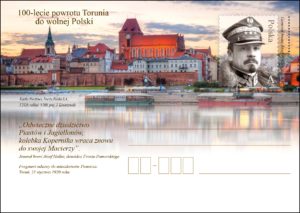
100 years of Torun’s return to free Poland …
denomination: 3,30 PLN; number of stationeries in set: 1;
print run: 8.000 pcs; printing technique: offset;
card size: 148 x 105 mm; author: J. Konarzewski;
release date: 18th January 2020.

75. Rocznica wyzwolenia niemieckiego nazistowskiego
obozu koncentracyjnego i zagłady Auschwitz
75th Anniversary of the liberation of German Nazi
concentration and extermination camp Auschwitz
www.poczta-polska.pl
W dniu 27 stycznia 2020 r. został wprowadzony do obiegu znaczek pocztowy o wartości 3,30 zł emisji “75. rocznica wyzwolenia niemieckiego nazistowskiego obozu koncentracyjnego i zagłady Auschwitz”. Znaczki wydrukowano techniką rotograwiurową, na papierze fluorescencyjnym, w formacie 31,25 x 25,5 mm, w nakładzie wielomilionowym. Arkusz sprzedażny zawiera 100 znaczków. Na znaczku umieszczono grafikę przedstawiającą otwartą bramę; w centralnej części znaczka – datę 27/I/1945 oraz napis: NIEMIECKI NAZISTOWSKI OBÓZ KONCENTRACYJNY I ZAGŁADY AUSCHWITZ. Z tej okazji została wydana koperta FDC. Autor projektu: Roch Stefaniak.

75th Anniversary of the liberation of German Nazi concentration
and extermination camp Auschwitz … denomination: 3,30 PLN;
number of stamps in set: 1; print run: multimillion pcs;
100 pcs in the sheet; printing technique: rotogravure;
stamp size: 31,25 x 25,5 mm; author: Roch Stefaniak;
release date: 27th January 2020.

Skarby Stanisława Augusta – Zygmunt III Waza (1587−1632)
www.nbp.pl
Skarby Stanisława Augusta … Wyjątkowa seria złotych i srebrnych monet kolekcjonerskich o nominałach 500 zł i 50 zł – „Skarby Stanisława Augusta” – odwzorowuje słynną osiemnastowieczną serię medalierską z wizerunkami królów Polski wykonaną na zlecenie Stanisława Augusta Poniatowskiego. Królewskie medale powstawały w mennicy warszawskiej w latach 1791–1797/1798. Ich twórcami byli dwaj wybitni medalierzy Jan Filip Holzhaeusser i Jan Jakub Reichel. Medale były wzorowane na portretach namalowanych w latach 1768–1771 przez Marcella Bacciarellego do Pokoju Marmurowego w Zamku Królewskim w Warszawie. Monety emitowane przez Narodowy Bank Polski są wiernymi replikami medali, zachowują średnicę i wysokość reliefu oryginałów. Dotyczy to portretów królewskich prezentowanych na rewersach monet. Odwrotne strony medali z życiorysami królów, umieszczone na awersach monet, zostały pomniejszone, ponieważ towarzyszy im otok z nazwą państwa, godłem Rzeczypospolitej, nominałem oraz rokiem emisji.
Życiorysy monarchów, jak również napisy na awersach medali towarzyszące portretom władców, zredagowane są po łacinie. Ostatecznej redakcji tych tekstów dokonał zapewne sam król Stanisław August. Imiona monarchów w języku polskim umieszczone zostały na boku monet; tamże znajduje się nazwa serii „Skarby Stanisława Augusta”. Poczet królów polskich wykonany na zlecenie Stanisława Augusta Poniatowskiego składał się z wizerunków 23 monarchów. Był tu o jeden portret królewski więcej niż na obrazach Bacciarellego, którego cykl obejmuje 22 obrazy. Dodatkowy portret Stanisława Leszczyńskiego, umieszczony na medalu, powstał najprawdopodobniej na podstawie obrazu Jana Bogumiła Plerscha. Obie serie, malarska i medalierska, zaczynają się od Bolesława Chrobrego, a kończą wizerunkiem Augusta III Sasa. W Pokoju Marmurowym od XVIII wieku naczelne miejsce zajmuje jednak kilkakrotnie większy od pozostałych królewskich portretów wizerunek Stanisława Augusta w pełnej postaci, w stroju koronacyjnym. Zapewne więc i serię medalierską zamykać miał medal z wizerunkiem aktualnie panującego monarchy. Abdykacja, emigracja i rychła śmierć króla w początku 1798 r. uniemożliwiły realizację tego zamierzenia. Seria monet „Skarby Stanisława Augusta” obejmuje 24 wizerunki monarchów – 23 z oryginalnej serii królewskiej oraz portret Stanisława Augusta, odtworzony według medali z epoki. Tak jak w XVIII wieku medale, monety będą bite w złocie i w srebrze. Informacja: Tomasz Bylicki, starszy kustosz Muzeum Historyczne m. st. Warszawy.
Nominał 500 zł … metal: Au 999,9/1000 stempel: zwykły średnica: 45 mm masa: 62,2 g napis na obrzeżu: SKARBY STANISŁAWA AUGUSTA * ZYGMUNT III WAZA * nakład: do 600 szt. Projektant rewersu – Anna Wątróbska-Wdowiarska Projektant awersu oraz napisów na rewersie – Robert Kotowicz Na zlecenie NBP monetę wyprodukowała Mennica Polska S.A. Emisja: 23 stycznia 2020 r.


Jana króla szwedzkiego syn, Zygmunta I z matki Katarzyny wnuk, obrany Roku Pańskiego 1587 dnia 19 sierpnia, pojmawszy w niewolę Maksymiliana Austriaka, współzawodnika do tronu, koronowany 27 grudnia, królestwo szwedzkie utracił dla stałości w wierze katolickiej. Za jego panowania sąsiedni Polsce nieprzyjaciele po wielekroć zgromieni, Smoleńsk przez niego samego wzięty, z Turkami chwalebny pokój zawarty, wojny domowe przytłumione. Umarł w Warszawie na Zamku, który odnowił, roku pańskiego 1632, mając lat 66, w 45. roku panowania, dnia 30 kwietnia.
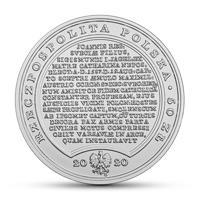

Nominał 50 zł … metal: Ag 999/1000 stempel: zwykły średnica: 45 mm masa: 62,2 g napis na obrzeżu: SKARBY STANISŁAWA AUGUSTA * ZYGMUNT III WAZA * nakład: do 5000 szt. Projektant rewersu – Anna Wątróbska-Wdowiarska Projektant awersu oraz napisów na rewersie – Robert Kotowicz Na zlecenie NBP monetę wyprodukowała Mennica Polska S.A. Emisja: 23 stycznia 2020 r.
Zygmunt III Waza (1587−1632) … Szesnasta moneta serii przedstawia Zygmunta III z dynastii Wazów, syna króla Szwecji Jana III i Katarzyny Jagiellonki, córki Zygmunta I Starego. Walczył o polski tron z arcyksięciem Maksymilianem Habsburgiem. Obrany na polskiego króla i koronowany w 1587 r., po śmierci ojca w 1592 r. objął również tron szwedzki. W 1599 r. szwedzki sejm ogłosił jego detronizację. Zygmunt III toczył liczne wojny i rozszerzył terytorium Polski do największych w dziejach rozmiarów. Był to także okres wielkiej prosperity gospodarczej Rzeczypospolitej, choć sam król nie zyskał pochwały ani u współczesnych, ani u potomnych. Na rewersie monety widnieje przeniesione z medalu popiersie króla (według obrazu pędzla Marcella Bacciarellego) profilem w prawo, z wąsami i bródką, w wysokim kapeluszu ze szkofią, w dużym koronkowym kołnierzu, w kaftanie z guzkami i płaszczu z haftem oraz z Orderem Złotego Runa na łańcuchu. Na awersie monety umieszczono nieznacznie skrócony tekst z rewersu medalu (w tłumaczeniu): Jana króla szwedzkiego syn, Zygmunta I z matki Katarzyny wnuk, obrany Roku Pańskiego 1587 dnia 19 sierpnia, pojmawszy w niewolę Maksymiliana Austriaka, współzawodnika do tronu, koronowany 27 grudnia, królestwo szwedzkie utracił dla stałości w wierze katolickiej.
Za jego panowania sąsiedni Polsce nieprzyjaciele po wielekroć zgromieni, Smoleńsk przez niego samego wzięty, z Turkami chwalebny pokój zawarty, wojny domowe przytłumione. Umarł w Warszawie na Zamku, który odnowił, roku pańskiego 1632, mając lat 66, w 45. roku panowania, dnia 30 kwietnia. Zygmunt Waza urodził się w 1566 r. w Szwecji, na zamku w Gripsholm, gdzie do 1567 r. więziono jego rodziców. Królewicz wychowywany przez jezuitów stał się gorliwym katolikiem, niechętnym innowiercom. Jego oponentem był m.in. Jan Zamoyski, wielki humanista epoki. Roszczenie Zygmunta do korony szwedzkiej po jej utracie w 1599 r. było przyczyną długoletnich wojen. Równie niepopularna w Rzeczypospolitej polityka prohabsburska prowadziła do konfliktów z Turcją, a zbrojna interwencja w Moskwie (tzw. dymitriady i krótkotrwałe osadzenie na tronie carów syna Władysława) skończyła się niepowodzeniem. Zygmunt był dwukrotnie żonaty – z Anną i Konstancją Habsburżankami, doczekał się sześciorga dzieci, wśród nich późniejszych królów Polski Władysława i Jana Kazimierza. Przeniósł swą rezydencję do Warszawy oraz zapisał się jako wybitny mecenas i protektor sztuki czasu manieryzmu i wczesnego baroku. Zmarł w Warszawie w 1632 r. i został pochowany na Wawelu. Informacja: Marta Męclewska.

Treasures of Stanislaw August – Sigismund Vasa (1587−1632)
www.nbp.pl
Treasures of Stanislaw August … The unique series of gold and silver collector coins with the face values of 500 zloty and 50 zloty – “TREASURES OF STANISŁAW AUGUST” – replicates the famous 18th century medallic series with the images of the kings of Poland, which was struck on the order of Stanisław August Poniatowski. The royal medals, designed by two outstanding medallists: Jan Filip Holzhaeusser and Jan Jakub Reichel, were struck at the Warsaw mint in the years 1791–1797/1798. The design of the medals was based on portraits painted between 1768 and 1771 by Marcello Bacciarelli for the Marble Room at the Royal Castle in Warsaw. The coins issued by Narodowy Bank Polski are faithful replicas of the medals, preserving the diameter and height of relief of the originals. This applies to the portraits of the kings on the reverses.
The obverses of the coins feature the reverses of the medals with biographies of the monarchs. The reverses of the medals have been reduced in size because they are accompanied by the name of the state along the rim, the image of the state emblem, the face value and the year of issue of the coins. The biographies of the monarchs and the inscriptions on the obverses of the medals accompanying the royal portraits are in Latin. The final text editing was most likely done by King Stanisław August himself. The names of the monarchs in Polish are presented on the sides of the coins, along with the name of the series “Treasures of Stanisław August”. The gallery of portraits of Polish kings, painted on the order of Stanisław August Poniatowski, consisted of images of 23 monarchs. It included one royal portrait more than Bacciarelli’s series of 22 paintings. The additional portrait of Stanisław Leszczyński – featured on the medal – was most probably modelled on a painting by Jan Bogumił Plersch.
Both series, the paintings, and the medals begin with the image of Bolesław Chrobry and end with the portrait of August III. Since the 18th century, the principal place in the Marble Room has belonged to the portrait of the full-length figure of Stanisław August in his coronation robes. The painting is several times larger than other portraits. It is therefore probable that the medallic series would have finished with a medal presenting the image of the ruling monarch. However, these plans were thwarted by the king’s abdication, emigration and early death at the beginning of 1798. The series of coins “Treasures of Stanisław August” consists of 24 portraits of monarchs – of which 23 have been modelled on the royal series plus a portrait of Stanisław August based on the medals from the period. The series will be struck in silver and gold, as was the practice in the 18th century. Info: Tomasz Bylicki, senior curator Historical Museum of Warsaw.
Face value: 500 zł … metal: Au 999.9/1000 finish: standard diameter: 45 mm weight: 62.2 g On the edge, the inscription: SKARBY STANISŁAWA AUGUSTA * ZYGMUNT III WAZA * mintage: up to 600 pcs Designer: reverse – Anna Wątróbska-Wdowiarska Obverse and inscriptions on the reverse – Robert Kotowicz Producer: Mennica Polska S.A. commissioned by NBP Date of issue: 23 January 2020.


The son of the Swedish King John, the grandson of Sigismund the Elder by his mother Catherine, elected on the 19th day of August Anno Domini 1587, having captured Maximilian of Austria, his rival to the throne, and crowned on the 27th day of December, he forfeited the Swedish kingdom because of his adherence to the Catholic faith. During his reign, Poland’s neighbouring enemies were vanquished many a time, Smoleńsk was seized by the king’s army, a commendable peace treaty was signed with the Turks and civil wars were suppressed. He died in Warsaw, at the castle he had renovated, on the 30th day of April Anno Domini 1632, at the age of 66, in the 45th year of his reign.


Face value: 50 zł … metal: Ag 999/1000 finish: standard diameter: 45 mm weight: 62.2 g On the edge, the inscription: SKARBY STANISŁAWA AUGUSTA * ZYGMUNT III WAZA * mintage: up to 5,000 pcs Designer: reverse – Anna Wątróbska-Wdowiarska Obverse and inscriptions on the reverse – Robert Kotowicz Producer: Mennica Polska S.A. commissioned by NBP Date of issue: 23 January 2020.
Sigismund Vasa (1587−1632) … The sixteenth coin in the series depicts Sigismund III of the Vasa dynasty, the son of the Swedish King John III and Catherine Jagiellon, a daughter of Sigismund the Elder. He competed for the Polish throne with Maximilian III, Archduke of Austria. He was elected Polish king and crowned in 1587. Following his father’s death in 1592, he also took over the Swedish throne. In 1599, the Swedish parliament announced his dethronement. Sigismund Vasa waged numerous wars and enlarged Poland’s territory to its biggest size in history. While this period in the Commonwealth of Poland was marked by great economic prosperity, the king himself did not gain much praise from either his contemporaries or posterity. The reverse of the coin features the bust of the king transferred from a medal (according to a painting by Marcello Bacciarelli) with the profile facing right, with a mustache and a small beard, in a high hat with a jeweled feather brooch, in a large lace collar, wearing a caftan with studs and an embroidered coat, and with the Order of the Golden Fleece on a chain.
The obverse of the coin carries a slightly shortened version of the text from the reverse of the medal (in translation): The son of the Swedish King John, the grandson of Sigismund the Elder by his mother Catherine, elected on the 19th day of August Anno Domini 1587, having captured Maximilian of Austria, his rival to the throne, and crowned on the 27th day of December, he forfeited the Swedish kingdom because of his adherence to the Catholic faith. During his reign, Poland’s neighbouring enemies were vanquished many a time, Smoleńsk was seized by the king’s army, a commendable peace treaty was signed with the Turks and civil wars were suppressed. He died in Warsaw, at the castle he had renovated, on the 30th day of April Anno Domini 1632, at the age of 66, in the 45th year of his reign.
Sigismund Vasa was born in 1566 in Sweden, at the castle in Gripsholm, where his parents were imprisoned until 1567. Brought up by the Jesuits, the young prince became a devout Catholic, averse to the heretics. His opponents included Jan Zamoyski, a great humanist of the epoch. Sigismund’s claim to the Swedish crown after losing it in 1599 led to long-lasting wars. Equally unpopular in the Commonwealth of Poland, his pro-Habsburg policy led to conflicts with Turkey, while the armed intervention in Moscow (the so-called Dymitriads and the brief enthronement of his son Ladislas on the Tsars’ throne) ended in failure. Sigismund was married twice – to Anna Habsburg and Constantia Habsburg, and fathered six children, among whom were the subsequent Polish kings, Ladislas and John Casimir. The king moved his residence to Warsaw and earned a reputation for being an outstanding patron and protector of the arts in the time of Mannerism and early Baroque. He died in Warsaw in 1632 and was buried in Wawel Cathedral. Info: Marta Męclewska.


England Claims Its First Colony
www.canadapost.ca https://postagestampguide.com
Newfoundland’s first colonists spent a short seventeen days there, long enough for Sir Humphrey Gilbert (1539?-83) to take possession of the island in the name of Queen Elizabeth I. In 1583 Gilbert, a soldier and navigator, sailed to Newfoundland accompanied by four ships and 260 potential colonists. On August 3 he landed at the site of St. John’s and on August 5 he erected a wooden pillar bearing the royal arms. About two weeks later, when members of his company grew ill, he sent them back to England while he continued south to search for a more hospitable site for a colony. East of Nova Scotia one of his ships went down and the discouraged navigator turned his course to England. When his ships, the Golden Hind and the Squirrel, were almost in sight of home, a storm blew up and the Squirrel, with Sir Humphrey on board, went down. Legend has it he was last seen seated on the deck with a book in his hands, saying, “Cheer up, lads, we are as near to heaven by seas as by land.” (52-IV-20)

Sir Humphrey Gilbert … Date of Issue: August 3, 1933; Denomination: 1¢; Perforation or Dimension: 13.5; Series : Sir Humphrey Gilbert ; Printer: Perkins, Bacon & Company Limited; Postal Administration: Newfoundland. Engraved by Alfred J. Downey.

The Token from Her Majesty … Date of Issue: August 3, 1933; Denomination: 5¢; Perforation or Dimension: 13.5; Series : Sir Humphrey Gilbert ; Printer: Perkins, Bacon & Company Limited; Postal Administration: Newfoundland. Designed by Louis Olga Mary Lehmann.

Dahlias: PermanentTM Domestic stamps
www.canadapost.ca
Deliver delight with this booklet of 10 PermanentTM domestic stamps featuring dahlias. The two stamps from Canada Post’s annual flower issue, depict two dahlias in bright fresh colours. A favourite among Canadian gardeners, the dahlia is native to the mountainous regions of Mexico and Central America and is related to the sunflower, chrysanthemum, and daisy.

Stamp Value … PermanentTM (domestic rate);
Quantity Produced: 600,000; Dimensions: 26 mm x 32 mm;
Stamp Designer: Lionel Gadoury, Umaymah Motala,
Malika Soin | Context Creative; Issue Date: March 2, 2020.
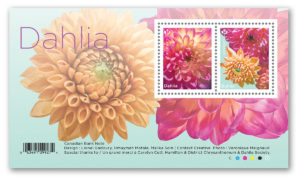
Dahlias: Souvenir sheet … Delight in the beauty of dahlias with this pretty souvenir sheet. This colourful collectible includes both PermanentTM domestic stamps from Canada Post’s annual flower issue. Stamp Value: 2 x PermanentTM (domestic rate); Quantity Produced: 70,000; Dimensions: 127 mm x 73 mm; Stamp Designer: Lionel Gadoury, Umaymah Motala, Malika Soin | Context Creative; Issue Date: March 2, 2020.

Dahlias: Official First Day Cover … Add a touch of spring to your collection with this Official First Day Cover featuring delightful dahlias. This elegant collectible bears both PermanentTM domestic stamps from Canada Post’s annual flower issue. The stamps depict dahlias in striking shades of fuchsia and orange, while the Official First Day cover features an enlarged version of a dahlia bloom. The Official First Day Cover is cancelled in Bloomfield, Newfoundland, and Labrador. Stamp Value: 2 x PermanentTM (domestic rate); Quantity Produced: 7,000; Dimensions: 190 mm x 112 mm; Stamp Designer: Lionel Gadoury, Umaymah Motala, Malika Soin | Context Creative; Issue Date: March 2, 2020.


2019 … 25-Cent Coin – First Canadian in Space
www.canadapost.ca www.mint.ca
October 5, 1984. 7:03:00 a.m. EDT. Blast off. Space Shuttle Challenger lifts off, carrying Marc Garneau, the first Canadian to travel into space. One of the seven crew members of Mission STS-41-G, Garneau conducted multiple Canadian-designed experiments as a payload specialist. After 8 days + 5 hours, orbiting Earth 133 times, the astronaut came back to Earth a Canadian hero. He would later set out on two more space flights: STS-77 in 1996 and STS-97 in 2000.
The 2019 tri-metallic 25-cent coin honours the 35th anniversary of Marc Garneau’s incredible achievement with a Mint first: a ground-breaking design featuring cutting-edge technology. This must-have collector’s coin proudly commemorates an iconic piece of Canadian history while celebrating all innovative Canadians. The Astronaut: Marc Garneau, first Canadian in space … “October 5, 1984. I remember it as if it were yesterday. What an exhilarating and humbling moment! Witnessing Earth from space, one understands how infinitely small we are and yet, how capable we are of immense innovations. I remain forever grateful to have been selected for this historic flight. This homage is a true honour and a splendid token to share an unforgettable moment with my fellow Canadians.” Orbit within the thermosphere! The coin’s unique tri-metal design rockets the space shuttle through rings representing different layers of the atmosphere. Honouring an icon of space travel, Marc Garneau was the first Canadian to travel into space.
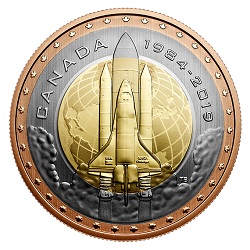
Face value: 25 cents … Composition: Tri-metallic
(Brass, cupronickel and bronze); Mintage: 15,000;
Finish: specimen; Weight: 51.31 g; Diameter: 50.25 mm;
Edge: serrated; Certificate: serialized;
Artist: Tony Bianco (reverse), Susanna Blunt (obverse).
Design: The reverse features a central core image of Challenger superimposed over Earth. The realistic design of the space shuttle is surrounded by concentric circles representing different sections of Earth’s atmosphere. The inner core represents the troposphere where the shuttle launched, the inner ring is the thermosphere where the shuttle orbited, and the outer ring in outer space. The 35 maple leaves which adorn the outer ring represent the commemorated 35 years, also identified with the “1984–2019” as printed on the coin along with “CANADA.” The obverse features the effigy of Her Majesty Queen Elizabeth II by Susanna Blunt, also surrounded by 35 maple leaves. “Embracing the challenge of designing a coin with tri-metal technology, I worked with engineers and colleagues to create a coin that outshined all others. We considered each metal’s implication and impact in the 3D modelling, and then set about the process, which involved engraving tooling work, 3D rendering, and post-production. This is definitely a fascinating addition to my collection!” Ms. Aida Alves: Engraver.
Did you know… As a payload specialist during STS-41-G, Marc Garneau conducted experiments related to space science and technology, as well as life sciences. Payload specialists were nominated for specific shuttle missions by NASA and other space agencies, based on their specific skills and expertise. These highly skilled experts embarked upon missions with precise, specialized duties associated with their education and training.
In December 1983, Marc Garneau was selected to be part of the new Canadian astronaut corps. His training would begin in February 1984. In addition to being the first space flight to carry a Canadian, the mission boasted numerous other firsts. The mission included the first Australian and was the first with two women, one of whom became the first woman to perform a spacewalk. The team, comprised of seven astronauts, also became the largest crew to ever fly on a spacecraft.

2020 … 5-Cent Bronze Coin
– The Canadian Home Front: The Victory Nickel
www.canadapost.ca www.mint.ca
Canada, 1943. With the disastrous Dieppe Raid still fresh in their minds, Canadians began the year with tragic news from the Battle of the Atlantic and ended it with successes in Sicily. The end of the war was still two years away. But 1943 brought a hopeful shift that was fuelled in part by Canada’s effort on the home front, where our sacrifices and resolve were represented by a coded message on a new 5-cent coin: We Win When We Work Willingly. Enhanced with special finishes, this bronze coin re-creates a historic design that is a favourite of collectors and historians. The reverse is a three-part tribute: to Canada’s nickel-less 1943 Victory nickel; to its creator, Thomas Shingles; and to the Canadians on the home front, where civilian contributions were crucial to the war effort and, ultimately, the Allied victory.
Canada’s famous Victory nickel is brought back to life on this modern tribute to the design and the artist. The use of a bronze alloy is a nostalgic nod to the tombac version of the Victory nickel (1943-44), while the specimen finish has a similar look to the steel version (1944 – 45). With the exception of a modern alloy, an updated bilingual coded message and a much larger size, this collectible piece of history is the culmination of our painstaking attempts to remain faithful to the original design introduced in 1943. Both sides of history. In keeping with the spirit of the original coin, our modern-day version features the same effigy of King George VI.
Design: Your coin re-creates the celebrated Victory design by Thomas Shingles that appeared on Canada’s five-cent coins between 1943 and 1945. A flaming torch represents the sacrifices made by Canadians at home and on the battlefields during the Second World War. Behind it, a big “V” has a dual meaning: it alludes to Sir Winston Churchill’s famous “V for Victory” sign and is also the Roman numeral that represents the denomination (5). On either side of the V are maple leaves, while traditional denticles are replaced by a bilingual version of the original message, “WE WIN WHEN WE WORK WILLINGLY LA BONNE VOLONTÉ EST GAGE DE VICTOIRE”, in Morse code. The obverse features the historical effigy of King George VI by T. H. Paget.
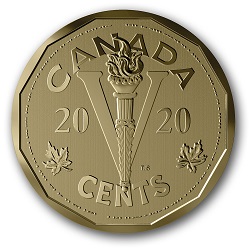
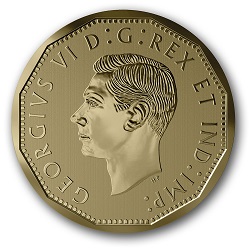
Face value: 5 cents … Composition: bronze; Mintage: 8,000;
Finish: specimen; Weight: 54.09 g; Diameter: 50 mm;
Edge: serrated; Certificate: serialized;
Artist: Thomas Shingles (reverse), Susanna Blunt (obverse).
Canada’s five-cent Tombac coin: On the home front, select metals were in short supply for “non-essential” use since they were key to the Allied war effort. This was especially true for nickel, a critical material in the production of weaponry and equipment such as armour plating. After introducing a 12-sided tombac (a bronze alloy) “nickel” in 1942, the Royal Canadian Mint also began work on a new five-cent design to promote Canada’s war effort. Sir Winston Churchill’s famous “V for Victory” sign inspired the final design, which included a coded patriotic message in place of denticles. But the master matrix had the added distinction of being the first one made entirely in Canada: it was hand-cut by the legendary Thomas Shingles, who became Chief Engraver of the Royal Canadian Mint that same year.
Did you know… Tombac, a bronze alloy with a high copper content and zinc, was used for all Canadian five-cent coins issued in 1942 and 1943. The composition changed to chromium-plated steel in 1944. And in 1946, the beaver returned to Canada’s five-cent coin, which was once again made of nickel. To avoid confusion with the cent, Canada’s nickel was re-designed in 1942 to feature 12 flat sides. It returned to a round shape in 1963. The design was re-issued in 2005 to commemorate the 60th anniversary of the end of the Second World War. It was also featured in our 2015 Legacy of the Canadian Nickel series.

2020 … $5 Pure Silver Coin – W Mint Mark
www.canadapost.ca www.mint.ca
This coin’s design is based on the iconic Maple Leaf bullion coins the Mint has produced since it introduced its first gold bullion coin in 1979. The Silver Maple Leaf bullion coin was introduced in 1988. It immediately set a new standard as the world’s first 99.99% pure silver bullion coin. It bears the same reverse design as the Gold Maple Leaf—a highly recognizable image created by Master Engraver Walter Ott. Several elements make this collectible unique. First, it celebrates the global renown of our Maple Leaf bullion coins, which continually set the standard for purity and security. Second, unlike any of our other numismatic or bullion coins, this is the first time a pure silver coin was produced at our facility in Winnipeg, Manitoba. It carries a “W” mint mark on its reverse to highlight that the coin was struck at our Winnipeg location. And finally, it features a unique burnished finish, giving it a ‘matte’ look, making this coin stand out from our other numismatic coins. The maple leaf celebrates our great nation in all its beauty and diversity; this coin is a great way to begin a collection, or a storied addition to any collection featuring Canadian, historical, or nature-themed coins.

Face value: 5 dollars … Composition: 99.99% pure silver;
Mintage:10,000; Finish: Burnished; Weight: 31.39 g;
Edge: serrated; Certificate: serialized; Diameter: 38 mm;
Artist: Walter Ott; Susanna Blunt (obverse).
Design: The reverse design for this coin reproduces Master Engraver Walter Ott’s maple leaf from the Mint’s original 1979 bullion coin. This design remains in use on all Royal Canadian Mint bullion coins to this day. The reverse also features a “W” mint mark to the left of the leaf stem, indicating that this numismatic coin was struck at our Winnipeg facility rather than in Ottawa, where numismatic coins are typically struck. The obverse includes the effigy of Her Majesty Queen Elizabeth II by Susanna Blunt.
Did you know… The Royal Canadian Mint first entered the global bullion coin market in 1979 with its Gold Maple Leaf bullion coin. At the time, the worldwide quality standard was 99.9% purity. Canada’s bullion coins immediately set themselves apart on the world stage for its purity—other metal alloys were absent in our bullion. Four years later, the Mint set a new global standard, a 99.99% pure Gold Maple Leaf bullion coin.
To create this coin, a die setter trainer, a Training Coordinator and a Quality Assurance associate from our Ottawa facility travelled to Winnipeg to teach the knowledge and process skills, for achieving the coin’s unique numismatic qualities.

2020 … $25 Pure Silver Coin – Toronto Raptors 25th Season
www.canadapost.ca www.mint.ca
Celebrate the heritage of the Toronto Raptors! Toronto was added to the NBA roster in the 1995-1996 season—an expansion that included two Canadian teams. Since 2001-2002, when the Vancouver Grizzlies were relocated to Memphis, Tennessee, the Raptors have been Canada’s only NBA team. Despite this seemingly solitary state, they have managed to host some of the league’s biggest superstars and have broken NBA records for attendance.
With a fanbase that stretches from coast to coast to coast, the Raptors truly are Canada’s team. Celebrate the 25th season of the Toronto Raptors with a coin featuring its classic logo from 1995-1996 inaugural season! This pure silver coin features a full-colour original Raptors logo backed by a stylized rendition of the basketball from the logo. An excellent addition to your Raptors fan collection and a unique addition to a coin collection featuring sports or Canadiana. Low mintage of only 8,500 coins—sure to be a hit and sell quickly among the Raptors’ large fan base. Every package includes an NBA authenticity hologram.

Face value: 25 dollars … Composition: 99.99% pure silver;
Mintage:8,500; Finish: Proof with colour; Weight: 31.39 g;
Edge: serrated; Certificate: serialized; Diameter: 38 mm;
Artist: Susanna Blunt (obverse).
Design: Your 99.99% pure silver coin features the original Toronto Raptors logo from 1995-96 to the 2007-08 season. The reverse is coloured in the logo’s original red, purple, black, and silver. The logo is set against a stylized rendition of the basketball featured in the logo. The obverse features the effigy of Her Majesty Queen Elizabeth II by Susanna Blunt.
Did you know… The 2018-2019 season marked the Raptors’ first in the NBA finals. Basketball’s origins are Canadian. Basketball was invented by Canadian James Naismith in 1891. The first-ever NBA game was played in Toronto in 1921.


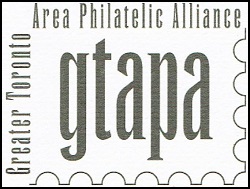
www.gtapa.org
The GTAPA is committed to promote and
stimulate the art of philately to all ages for fun,
culture, education, and friendship.




